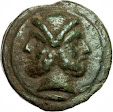Cast Uncia Capis Pedum
Central Italy, 280 - 260 BC
Mint – Uncertain Central Italy, see below.
Denomination - AE Cast Uncia
Mint date - 280-260 BC
Obv – Pitcher (also called Jug, Jug with handle, Capis, Oinochoe,
Oenochoe, kanne mit Henkel1); pellet (mark of value) to left.
Rev – Shephards crook (also called Pedum, Sistrum, curved club); pellet
(mark of value) to left.
31.32 grams, this is the heaviest coin I found in web searches. Only two of 44 coins in Haeberline were heavier.
30.5 X 31.2 X 8.1 mm
RR. Very rare. A superb cast in high relief. Dark green patina. Good VF.
Notes:
1. pot with handle – English translation of German text
References, I do not find this coin in Sear, Crawford or Grueber.
Vecchi ICC 308
Vecchi places this
coin under Unknown Mints in Central Italy, Central Itallian Issues not in
Recobnisable Series, 3rd century BC.
Thurlow & Vecchi, ICC – 223
Vecchi comments that
this coin might logically be ascribed to Asculum. He lists it in Uncertain
Central Italy, C. 280 – 260BC.
HN Italy – 386, pg 53, HNI notes there is an example in the Museo
Archelogico, Chieti
Uncertain Aes Grave,
This series are unattributed and can for the most part be dated in only a
general way to the first half of the 3rd centure BC.
Sydenham, Aes Grave – 112
Sydenham notes: This
coin is assigned to Latium-Campania and grouped in a series with a Lion’s Head
As by the editors of the Cat. Mus. Kirch. The arrangement is conjectural.
Sale cat – 134
& 135, Different types not groups from Latium-Campania.
Haeb. Page 168, 44 examples; pl. 68,23-25. AE.
Haeberline assigns
the coins to indeterminate individual communities in Latium or Campania
Garrucci – Pg 23 #6; Plate XLIII #6; Tibur, Latium
Tivoli is a town
twenty miles to the east of Rome (Tibur is the ancient name); a summer resort
during the Roman empire; noted for its waterfalls
BMC Italy Pg 59, # 32 – 35;
Uncertain Aes Grave
of Central Italy, using an the arrangement of Mommsen, Blacas, I, pg. 332 - 343.
This coin is in section C, coins of various classes. These coins cannot all be
attributed to Central Italy.
Kirchner – page 23, Tavola XI, N.6; Plate Class I, Tavole XI.
I do not see where
mint is mentioned. – Note: there is a coin that looks similar in Table Incerte
V #8
| eem data | Hab data | Eq As | |||
| Weight | 31.32 | eem data | haeb | eem coin | |
| Weight - max | 31.32 | 34.2 | |||
| Weight - min | 16.40 | 20.3 | |||
| Weight - avg | 23.5 | 24.8 | 284 | 298 | 376 |
| Weight - st dev | 3.8 | 2.9 | |||
| Number | 20 | 44 | |||
| Diameter - max | 31.2 | 8.1 thick | |||
| Diameter - min |
30.5
|
||||
| Diameter - max | 32.0 | ||||
| Diameter - min | 26.0 | ||||
| Diameter - avg | 29.9 | ||||
| Diameter - st dev | 1.5 | ||||
I picked up several cast bronze weights, coins and a shell. Clockwise in the picture below are a Semis, Quadrans (sized shell), Seztans and Uncia.
An oenochoe,
also spelled oinochoe (Ancient Greek: οἰνοχόη; from Ancient Greek: οἶνος oînos,
"wine" and Ancient Greek: χέω khéō, "I pour"; plural
oenochoai or oinochoai), is a wine jug and a key form of ancient Greek pottery. See below.
Wikipedia
A pedum is a shepherds staff (crook). The pic below shows David holding a sling and pedum.
David: slinging at Goliath -- David, with pedum in left hand, swings
sling in right hand. Stone strikes forehead of Goliath, in mail, wearing broad
helmet, removing sword from scabbard.
Pierpont Morgan Library. Manuscript.
M.638.
Old Testament Published/Created:
Paris, France, ca. 1244-1254.







No comments:
Post a Comment